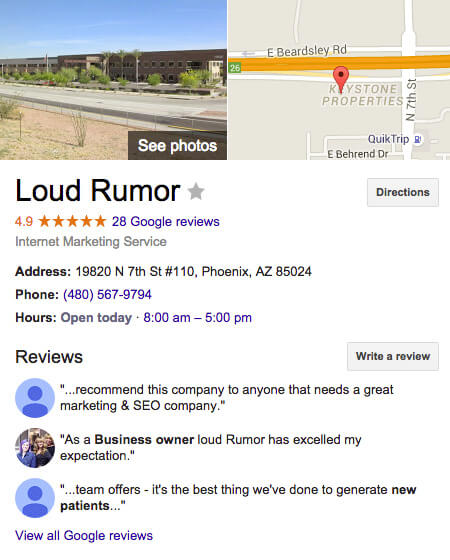
A Business Owner's Crash Course in Local SEO
Lets say you are a small business, a two man operation based out of that one city Bugs Bunny should have taken a left at and you're looking for more houses to tent for pest control. It's time to expand and you want to crush it online. Welcome to the world of internet marketing! The organic efforts and strategies that you practice for your Local SEO inevitably determine how you rank in search engines, what keywords you rank for, and how easily customers find you.
All of this is super important for your business' overall success. So let's break it down.... get ready for a crash course in Local SEO!
Step 1 - Do Your Research

Before you dive into your Local SEO efforts, you need to do some research. First, figure out what keywords and phrases you want your business to rank for, and which ones - realistically - to start with.
Your keywords are based on your specific industry, service, and location. The last thing you want is to choose a keyword that you won't rank for because it's too competitive or vague.
So a big part of this also includes competitor research. As a small business, you should know what your competitors are doing, what they're successful at, where they slack, and how you can do better than them. They may not like to see you passing them after you use this tactic, but it's part of the game.
That being said, keyword and competitor research go hand in hand. SERPWoo's Keyword Finder can help out tremendously since it takes into consideration the top 10 competitors for each seed keyword. Using Keyword Finder, you would input a single keyword - the seed keyword, and then let it process. The tool is still in beta so give it a moment if you inputted a broad term like 'pests' - try narrowing it down to 'pest control'.
When Keyword Finder is complete it will pull all related keyword terms first. Then in the second process it will pull the top 10 websites ranking for that seed keyword and THEN pull ALL their keywords they are ranking for. Keyword Finder will then display all this data for you in an easy format with color coordinated circles to represent the top 10 pages as the respective source for each keyword.

Keyword Finder in action
Step 2 - Setup Your Google My Business Page
Your Google My Business page is a must. There's no way around it. Getting listed here is your top priority when it comes to SEO.
When people search for your business on Google, the info from your Google My Business page shows up like in the right hand image of Loud Rumor.
Other directories that you'll eventually get listed in need to match your NAP (business name, address, and phone number) here. So your NAP on your Google My Business page needs to match exactly what's on your website.
Here's how to setup your Google My Business page:
- Go here and select "Get on Google"
- Sign in to your Gmail account for your business (If you don't already have one, this will need to be created as well)
- Follow the steps to verify your local business
- Add your business' information including industry, hours of operation, and any other final touches

Step 3 - Optimize Your Website
We already mentioned your NAP on your Google My Business page. Again, it needs to match exactly what's on your website. So make sure they're uniform. If you say "St." instead of "street" on your site, it should be consistent on your Google My Business Page. Your NAP should be in the footer of your website on the homepage, and also on your "Contact" page.
And once your keyword research is done, you'll want to use those findings on your site. Add your city and keywords to your page title, headers, images as alternate text, scattered throughout the content (but don't keyword stuff!). Wherever you can optimize, do it. Just don't get spammy.
Design also plays a huge role in for your end visitors and search engines evaluating your website. Elements to keep in mind and research include mobile design, a clear CTA (call to action), a clear phone number (clickable for mobile devices), parrallax elements (all the rage at the moment), images - lots and lots of them - the larger the better (but within reason for the device - think mobile and desktop), fancy animation helps - but don't get carried away and do things that are fancy to be fancy, and videos (hi-res of course) of your product/service and customers using them.
Step 4 - Build Your Local Citations
You want your business to get listed in the right directories. That way, you target your specific audience in the right location.
Here are a few places you'll want to start:
In each of these listings, you'll have the opportunity to put your NAP. Again, make sure it matches what's on your website (redundant, but necessary!). Once you cover your basic Local directories, you want to dive in a little deeper.
Look for other sites to connect your business with based on prominence, relevance, and location. If you're a dentist, for example, getting listed in HealthGrades is great because it's a quality site and relevant to your industry.
But keep in mind that you want to be a little choosey with your local citations. You want to connect with sites that actually help your business.

Step 5 - Gain A Social Media Presence
Social media is super important for any business. Why? Because 46% of web users look toward social media when making a purchase. And there are tons of different social media avenues out there:
Decide which ones are best for your industry and really go for it. Set up your accounts with your NAP. Post relevant content that engages customers - don't use social media solely to promote your business.
You don't want a potential customer to see one of your products, decide to check out your Facebook, and realize that you haven't posted the last year... that's not a good sign. So you need to be on top of your social presence. Hootsuite (highly recommended by Carter), Tweetdeck (now owned by twitter), Crowdbooster, SproutSocial, and Buffer are 4 great social medial management tools to look into for your own social media management. Look for ones that have access to YOUR preferred audience's social presence.
It doesn't make sense to get a management tool that connects Linkedin for example if you are targeting non-professionals and or the youth. Your target audience is key to your social presence - where you'll spend the most resources and time at for the biggest bang for your buck.
Step 6 - Wow Them With Content

Youtube videos are great for the WOW factor
Content marketing is a great way to boost your Local SEO. You can do this with a blog, videos, guides or E-books, and so on. Provide your audience with awesome material that's both valuable to them and boosts your Local SEO as well.
Even though there's a ton that goes into Local SEO for small businesses, this is a great place to start.
Follow these 6 steps and watch your business slowly raise in search results for both your industry, keywords, and location.
If you have any questions on how to expand on these steps, let us know! Our SEO gurus are all ears.
Similar Posts On SERPWoo
- How to Dominate Local Search Results with Smart Content (Tips & Techniques)
- Quality Collection Of Local SEO Tips
